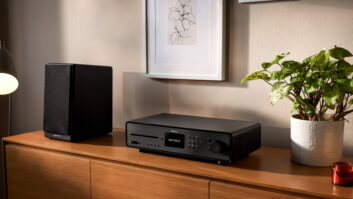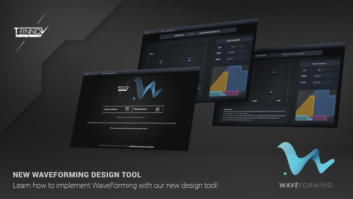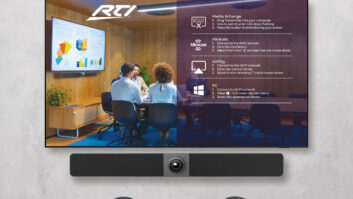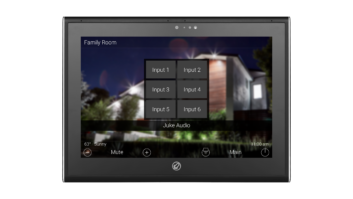I visited James Loudspeakers’ CEDIA booth one month before the company debuted its innovative design in Dallas on September 15. During a daylong tour of the loudspeaker manufacturer’s Napa, CA headquarters, visitors were shown an industrial-style gazebo of sorts in a large open space. A closer inspection of the aluminum-frame Lego-like structure revealed speakers housed within nearly every surface of the four corner posts, along the cross beams, and directly above. Created to demonstrate full Dolby Atmos, DTS:X, or Auro 3D audio on the CEDIA show floor, the open-sided enclosure may turn into a larger business opportunity for the company.

James Loudspeaker CTO Mike Park listens to his company’s room-within-a-room immersive audio booth before it shipped to CEDIA.
“Most companies spend a lot of money on fancy booths,” explained CTO Mike Park. “They don’t want to waste it, so they have to reuse for four years. We, on the other hand, have our own manufacturing capabilities. And this time, the booth itself is a also product.”
Park hopes to “productize” the James CEDIA booth like this: Let’s say your client has an unfinished concrete room or basement that he wants to turn into a home theater. He’ll have to frame it out and add drywall, which will take months and involve multiple trades. What if instead the client is presented with this modular “premium theater in a box” structure, which can be made more decorative and designed for any height, width, depth, and shape? Once manufactured, James can assemble its structure within one day. All wires are twist lock, for easy setup, and the entire design is outdoor-rated, so it can be used in a pool area for a very high-end outdoor cabana theater. The price isn’t cheap at $80,000, but we’re talking “premium performance” here.

The booth as it appeared in Dallas.
Not every product sold by James Loudspeaker is so conceptual, but the company’s speakers are known for their innovative designs and even custom-fabrication capabilities. The company does not believe in patenting its designs, yet claims many “firsts” within the category. From its 4-ohm and 70-volt landscape speaker systems, Power Pipe subwoofers, subterranean subwoofers, and Small Aperture in-ceiling speakers, James has seen its original concepts turn into categories for other speaker brands. The company’s executive team prefers to look ahead, rather than worry about being copied.
With the exception of a trio of minority stakeholders within the company, the three principal owners of James Loudspeakers are ex-Harman (JBL Pro division) employees. Mark Schafle serves as president, Park as chief technology officer, and Ted Telesky as chief marketing officer. The company was founded in 1999, focusing mostly on high-end bookshelf and tower speakers, until Schafle acquired the company in 2003 and hired Park. Telesky joined five years later. The company remains self-funded and carries no bank debt.


Chief marketing officer Ted Telesky shows one of his company’s Small Aperture speaker designs.James Loudspeaker CTO Mike Park and president Mark Schafle lead a tour of the James warehouse in Napa, CA.
James builds most of its products in either its Napa or Mexico facility, with only its speaker drivers manufactured by one dedicated supplier in Asia. All products are assembled, in just-in-time fashion, in the Napa facility, which features wood and aluminum fabricating areas with an automated CNC machine, aluminum powder-coating capabilities, and a large warehouse for shipping finished goods.
Beyond its custom-design capabilities, James is probably best known for manufacturing almost all of its speakers out of die-cast aluminum. The main benefit is sonic performance, particularly for in-wall/in-ceiling situations where the material’s light weight and rigid properties allow for more volume inside a speaker, but also for its durability in outdoor and marine applications. Every speaker in the line is outdoor rated.

James Loudspeaker product testing and powder coating and CNC machine
In that regard, the company doesn’t have a single paper cone product in its line and no plastic enclosures, either. Tweeter materials vary (beryllium, aluminum, soft domes, or titanium) depending on the application. Because a company can’t go out and buy these types of products, James engineers have to tool their own components and build them in-house.
Park is James Loudspeaker’s lead engineer, with expertise in compression driver design. Because of the custom nature of the company’s enclosure, he has created more than 25 different driver designs for the more than 140 speaker systems within the line.


Schafle’s mandate when he took charge 13 years ago was to find a way to differentiate the company from the competition by building unique products and creating “some custom stuff, buying as little as possible out of China.” Even as its original concepts get borrowed by others, there’s still no company doing quite what James Loudspeaker does with all outdoor-rated products in high-performance die-cast aluminum enclosures. And nobody is talking about building an indoor/outdoor modular immersive surround sound structure like the one I saw at its facility and again at CEDIA. That’s literally thinking outside the box.
Jeremy J. Glowacki is editorial director of Residential Systems.







